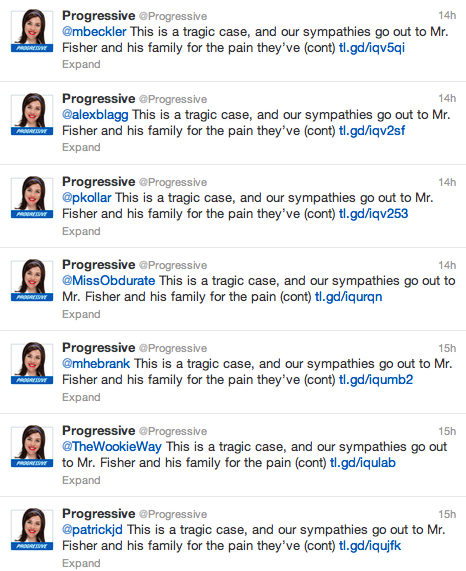Why You Should Review Your Avatar During A Crisis
Today’s article is a “small” post.
It’s about a topic that is definitely not one of the most important things you need to concern yourself with during a crisis. But since “small” things can sometimes send the wrong message and undermine your otherwise good work, it’s a small thing worth considering.
I first thought of this when I read in the New York Daily News a while back that Progressive Insurance was accused of providing “its own lawyers to help defend a man who accidentally killed one of its policy-holders in order to avoid paying the claim.”
That accusation—fueled by angry and very public posts by the victim’s family—created a major online stir. Progressive took to Twitter to deny the accusation. Here’s a snapshot of the tweets:
As you can see, Progressive’s avatar is that of “Flo,” the fictional spokeswoman who stars in the insurance giant’s ubiquitous television commercials.
Is it me, or does Flo’s broad smile undercut the words in Progressive’s tweets? I can’t help wondering whether Progressive would have done better by temporarily replacing the fictional “Flo” avatar with a real person—perhaps the head of Communications or the CEO? Even an impersonal Progressive logo might have been better than the goofy character.
@Progressive has only about 16,000 Twitter followers—but keep in mind that this series of tweets was embedded into dozens of news stories and blogs, expanding their reach into the hundreds of thousands or millions. And the fact that Progressive was sending out the same message over and over made this even worse, although that’s outside the scope of this article.
There’s one major disadvantage to changing an avatar. Your social media followers are familiar with your visual identity, and changing it during a crisis might make your tweets less noticeable at the very moment you want more people to see them.
What do you think? Should a company in crisis consider reviewing and replacing its avatar to ensure that their words are aligned with their visual message? Please leave your thoughts in the comments section below.




To me, what’s worse is the mechanical response. It would be OK sent once or maybe even twice, but repeatedly sending the identical message that many times seems very impersonal and contradicts the human side they’re hoping to show. Especially when you see 10+ identical responses. But they all have a different shortened URL – were they tracking every person’s click to the link? That seems a bit invasive to me. I find it hard to believe they’d be sending everyone to a unique URL but send the identical message to each one, so it’s got to be tracking.
I’m less bothered by the persistence of the avatar. I get your point, but I do think that keeping the recognized avatar is important. I think they could have improved the messaging and kept the avatar.
Kim,
You’re right about the mechanical response – Progressive got hammered in the press for their unfeeling approach (and deservedly so).
I didn’t notice the different URLs. I’d want to know whether that’s their standard protocol (a new link for every tweet), or whether that applied only in this case. I suspect it’s the former, in which case I wouldn’t make too much of that.
Thanks for weighing in on the avatar issue, as well. I’m torn on that one too — but somehow seeing Flo’s smiling mug in such a tragic case made me angry.
Hope you’re well!
Brad
I agree – the avatar doesn’t bother me so much as the seemingly detached message that is effortlessly repeated.
I can see your point about the avatar, Brad, and I think there’s something to it. One has to balance the brand recognition with the need to be serious on a serious issue. Perhaps the larger question is how can one come up with an avatar that is appropriate to communicating both good and bad news.
But I agree with Kim on the mechanical response issue. I maintain our Facebook page, and as you might expect we get a fair amount of disgruntled customers reaching out to us. I always try to apologize for the situation and the frustration they’re having, but I try to find different ways to say “I’m sorry” so that it never sounds canned. Social media is about authenticity, and copying and pasting the same response to so many people removes that authenticity entirely.